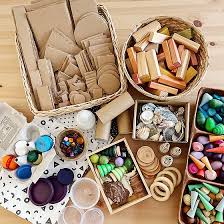Expressive Arts and Design
Our Intent
At Reddish Vale Nursery the day is structured to allow for maximum opportunities for open ended, free flow play. This enables children to be creative and build upon their ideas and experiences without interruption. Attitudes of curiosity and questioning are encouraged alongside the introduction of new skills and techniques.
Ofsted 2020
“Staff use their thorough knowledge of children’s development to plan activities that are just right for every child. Activities capture children’s imagination and link closely to their interests and ideas.”
Open ended materials
Loose parts and open ended materials are used in the continuous provision to encourage creativity and to provide children with a range of possibilities. The use of open ended materials encourages imagination, creativity and problem solving skills so play can be richer and more complex. Where possible, natural materials are used for example feathers and sticks are used in the dough area which leads to endless possibilities in play.
Process not product
At Reddish Vale Nursery staff understand and value the process that goes into children’s creativity, rather than a focus on the end product. Children are provided with a variety of resources aimed at teaching different skills and techniques. Adults ask open ended questions about what the children are doing in order to encourage confidence in their creativity.
Role play
Role play is values both indoors and outdoors. Domestic role play remains a consistent feature across the Nursery where learning opportunities are linked to realistic home experiences. We believe that re-enacting experiences from home is the best way to ensure role play is purposeful. Other types of role play are also valued and are used to build upon children’s interests.
“Expressive Arts and Design fosters imagination, curiosity, creativity, cognition, critical thinking and experimentation and provides opportunities to improvise, collaborate, interact and engage in sustained shared thinking. It requires time, space and opportunities to re-visit and reflect on experiences. Multi-sensory, first-hand experiences help children to connect and enquire about the world..” Birth to 5 matters – Non statutory guidance for the Early Years Foundation Stage



Implementation and Impact
2 year old provision
|
Implementation |
Impact |
Adaptations |
|
Children are encouraged to explore different media through messy play activities |
Experimenting with different media fosters problem-solving skills, critical thinking, and understanding cause and effect as children observe how materials behave and interact with each other. |
Use of Makaton and visuals Wide range of songs Songs in different languages/ cultures Symbolic representation of words Modelling adapted to each child Role play and small world resources represent different cultures/ people
|
|
Children have access to a wide range of open-ended resources. |
Open-ended resources allow children to use their imagination and creativity without constraints. There are no right or wrong ways to use them, fostering a sense of freedom and exploration. |
|
|
Children have the opportunity to paint on different materials and at different levels e.g. the easel, paper on the floor. |
Experimenting with different materials encourages children to think creatively and imaginatively. Each material offers unique properties and challenges, sparking curiosity and inspiring innovative approaches to artistic expression. |
|
|
Children explore colour mixing through different media. |
Understanding how colours blend and interact allows children to express themselves creatively through art. They can create custom palettes, experiment with different colour combinations, and convey moods or emotions. |
|
|
Children are supported to participate in different role play opportunities. |
Role play allows children to practice and rehearse real-life scenarios, such as doctor visits, grocery shopping, or pretending to be community helpers like firefighters or teachers. This prepares them for future experiences and builds confidence in handling everyday situations. |
|
|
Children are provided with opportunities for small world play. |
Small world play encourages children to use their imagination to create elaborate scenarios, storylines, and characters. They can invent miniature worlds and explore endless possibilities, fostering creativity and originality. |
|
|
Singing and dancing is explored through music and open space. |
Singing and dancing provide outlets for children to express a wide range of emotions, from joy and excitement to sadness and frustration. This emotional expression enhances their creativity by allowing them to explore and communicate their feelings in a nonverbal and artistic manner. |
|
|
Children are provided with opportunities to experiment with instruments. |
Musical instruments offer children opportunities to explore and experiment with different sounds, tones, and rhythms. They can discover how varying their actions produce different sounds, fostering curiosity and creativity. |
|
|
There is a children’s ‘art gallery’ to celebrate their work. |
When children see their artwork displayed, they feel encouraged to continue expressing themselves creatively. It reinforces the idea that their thoughts, feelings, and ideas are important and worthy of sharing with others. |
|
|
Real objects enhance children’s role play such as real food and playdough in the home corner. |
Real objects lend authenticity to role play scenarios, making the experiences more immersive and meaningful for children. They can interact with objects that resemble those they encounter in real life, enhancing their understanding and engagement. |
3/4 year old provision
|
Implementation |
Impact |
Adaptations |
|
Core books are shared frequently with the children to ensure familiarity with key texts |
The familiarity with core stories enables children to role play with familiar texts. Adults create opportunities for children to act out story scenes and retell stories in their play. Resources and texts are available to children; however they are encouraged to retell stories in their own way. |
Use of Makaton and visuals Wide range of songs Songs in different languages/ cultures Symbolic representation of words Modelling adapted to each child Role play and small world resources represent different cultures/ people
|
|
Children have access to a woodwork area using real tools |
Woodwork exercises creativity and problem-solving skills. Children are encouraged to make their own choices and learn through trial and error. Woodwork sparks creative thinking and imagination. Children learn through a progression in skills. For example, they start by sanding and screwing, progressing to gluing and then to hammering and sawing |
|
|
Creativity is encouraged through the large creative area with wide variety of materials and resources. |
With a wide range of resources at their disposal, children have the freedom to explore and experiment with various materials, textures, colours, and shapes. This hands-on exploration fosters creativity as children discover the properties and possibilities of different resources. |
|
|
Children explore colour mixing in paint and painting on and with different materials |
Experimenting with different materials encourages children to think creatively and imaginatively. Each material offers unique properties and challenges, sparking curiosity and inspiring innovative approaches to artistic expression. |
|
|
Children are provided with a range of other role play experiences indoor and out e.g. builders, hairdressers, vets, doctors, explorers |
Role play allows children to practice and rehearse real-life scenarios, such as doctor visits, grocery shopping, or pretending to be community helpers like firefighters or teachers. This prepares them for future experiences and builds confidence in handling everyday situations. |
|
|
Real objects are used where possible for example tyres, number plates, baby equipment, hairbrushes |
Real objects lend authenticity to role play scenarios, making the experiences more immersive and meaningful for children. They can interact with objects that resemble those they encounter in real life, enhancing their understanding and engagement |
|
|
Children are provided with opportunities for singing and music within continuous provision and a large space to explore movement. |
Singing and dancing provide outlets for children to express a wide range of emotions, from joy and excitement to sadness and frustration. This emotional expression enhances their creativity by allowing them to explore and communicate their feelings in a nonverbal and artistic manner. |
|
|
Children are provided with a variety of small world resources including animals, dinosaurs, people, transport |
Small world play encourages children to use their imagination to create elaborate scenarios, storylines, and characters. They can invent miniature worlds and explore endless possibilities, fostering creativity and originality. |
|
|
Children are taught to use musical instruments and partake in group times based on music |
Musical instruments offer children opportunities to explore and experiment with different sounds, tones, and rhythms. They can discover how varying their actions produce different sounds, fostering curiosity and creativity. |
|
|
Children are provided with open-ended large scale resources such as large blocks, boxes, crates, fabric |
Open-ended resources allow children to use their imagination and creativity without constraints. There are no right or wrong ways to use them, fostering a sense of freedom and exploration. |
|
|
|
|
|
Knowledge and Skills progression
|
Knowledge and Skills progression in the 2s
Emerging
Developing
Secure
|
Knowledge and Skills progression in the 3s and 4s Emerging
Developing
Secure
|
Open ended materials
Loose parts and open ended materials are used in the continuous provision to encourage creativity and to provide children with a range of possibilities. The use of open ended materials encourages imagination, creativity and problem solving skills so play can be richer and more complex. Where possible, natural materials are used for example feathers and sticks are used in the dough area which leads to endless possibilities in play.
.

Core books
The familiarity with core stories enables children to role play with familiar texts. Adults create opportunities for children to act out story scenes and retell stories in their play. Resources and texts are available to children, however they are encouraged to retell stories in their own way.
Process not product
At Reddish Vale Nursery staff understand and value the process that goes into children’s creativity, rather than a focus on the end product. Children are provided with a variety of resources aimed at teaching different skills and techniques. Adults ask open ended questions about what the children are doing in order to encourage confidence in their creativity.


Role play
Role play is values both indoors and outdoors. Domestic role play remains a consistent feature across the Nursery where learning opportunities are linked to realistic home experiences. We believe that re-enacting experiences from home is the best way to ensure role play is purposeful. Other types of role play are also valued and are used to build upon children’s interests.


